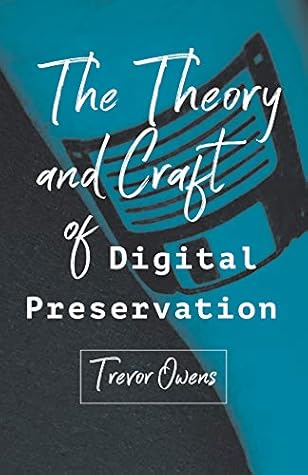Kindle Notes & Highlights
by
Trevor Owens
Read between
November 22, 2021 - March 28, 2022
The widely accepted definition of preservation in these domains holds that it is “action taken to retard or prevent deterioration of or damage to cultural properties by control of their environment and/or treatment of their structure in order to maintain them as nearly as possible in an unchanging state.”
Librarians have developed a sophisticated conceptual model for describing different levels of sameness for books—Functional Requirements for Bibliographic Records (FRBR).
database represents the world as a list of items and it refuses to order this list.”
As a proprietary format, the MP3 generates money every time an application runs it.
The Oregon Trail, an educational video game released in a variety of incarnations and versions dating back to 1971, is a bit of an iconic and nostalgic touchstone for people who grew up in the United States in the 1980s and 1990s.
So some player, presumably named Andy, put a misspelled joke about this commercial in his copy of the game and then let others copy his copy of the game. That copy of the game then became the basis for many pirated copies of it, and as a result the monument that player wrote into their local copy of the game has become a commemoration that took on a life of its own as a meme outside the game world.4 The saved game information on that particular copy of the game has become part of the game’s cultural meaning. This example illustrates the ways that folkloric objects, which have largely been
...more
The comic visualizes the way that file names created for quick use, like “Old Desktop,” end up becoming permanent parts of the organization of information and the way that, in practice, copying forward old files feels much like scraping off layers of sediment, and reading back into our past. The artifactual is encoded up and throughout the layers and carried forward through time as data makes its way from one medium to the next.
Digital preservation must be a craft and not a science because its praxis is (1) grounded in an ongoing and unresolved dialogue with the preservation professions, and (2) it must be responsive to the inherent messiness and historically contingent nature of the logics of computing.
This is one of the key reasons being intentional about preservation early and returning to those intentions often are so essential. While you could just keep “the stuff,” it’s possible that what matters about “the stuff” isn’t inside it but something that would best be recorded or documented through other means.
This point is true of preservation in general. You can preserve the heavy machinery equipment from a factory, but that won’t tell you much about the lived experience of working there. If you want to know about that, doing an oral history project with the factory workers would likely give you better material to preserve. You can preserve letters and artifacts left at the Vietnam War Memorial. However, photos and videos of people interacting with the memorial and the personal stories they share enable different kinds of understanding of how the monument functions. You can preserve the score of a
...more
Where in the past, I imagine, a cataloger would have needed to create a record for my dissertation, the system is now set up in such a way that the work of doing that is handed off to the dissertation’s author. Institutional repositories are used for much more than dissertations; many contain items like meeting minutes, podcasts, PowerPoint presentations, research data sets, video recordings, and more. The strength of this system (largely, that the keys have been handed over to the users) is simultaneously its biggest weakness. It is easy for these systems to become a “roach motel” where
...more
These app-collected interviews, and other crowd-sourced collecting efforts, come with exactly the same potential issues as the materials in an institutional repository. That is, because the metadata for this collection is user generated, it is inevitably not going to be as consistent and comprehensive as the metadata created by trained professionals. The result of this is that user-experience design, doing iterative testing in the development of interfaces and work flows, becomes critical to the ability of these kinds of systems. This
By all means, use what you have available to you. However, don’t allow these systems to foreclose the best way for you to provide access to your content. Don’t let the functionality of a system drive your decisions about describing and arranging your content.
In keeping with much of the discourse of computing in contemporary society, there is a push toward technological solutionism that seeks to “solve” a problem like digital preservation. I’ve suggested that there isn’t a problem so much as there are myriad local problems contingent on what different communities value. One of the biggest problems in digital preservation is that there is a persistent belief by many that the problem at hand is technical. Or that digital preservation is a problem that can be solved.
Our remit in the social order as it exists is to imagine how to take the tools created to surveil and control and see if we can find ways to bend them to protect and preserve. It’s essential that we do not go into this work blind. The tools of digital technology are not here to emancipate us.


